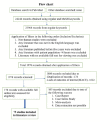Major Adverse Cardiovascular Events: An Inevitable Outcome of ST-elevation myocardial infarction? A Literature Review
- PMID: 31423405
- PMCID: PMC6695291
- DOI: 10.7759/cureus.5280
Major Adverse Cardiovascular Events: An Inevitable Outcome of ST-elevation myocardial infarction? A Literature Review
Abstract
Major adverse cardiovascular events (MACE) remain the major cause of mortality and morbidity in patients with STEMI (ST-elevation myocardial infarction). The current literature is aimed to analyze the occurrence of MACE following STEMI irrespective of treatment provided, and follow up after the first diagnosis of STEMI. A PubMed search for Studies of STEMI identified 24,244 articles. After applying our inclusion/exclusion criteria, we found out 75 articles of relevance wherein MACE and its components were considered to be the primary endpoint. These 75 articles included eight Cohort Studies, 13 clinical trials including five randomized controlled trials (RCT), one case-control Study, one cross-sectional study, one review article, and 51 other observational studies. Our analysis shows that MACE remains one of the strongest adverse outcomes among STEMI patients. The current literature review found out the incidence of MACE was 4.2 % to 51% irrespective of the mode of treatment, and follow-ups lasting up to 10 years from the time of STEMI diagnosis.
Keywords: stemi; stemi complications; stemi major adverse cardiovascular events; stemi review.
Conflict of interest statement
The authors have declared that no competing interests exist.
Figures
References
-
- 2013 ACCF/AHA guideline for the management of ST-elevation myocardial infarction. O’Gara PT, Kushner FG, Ascheim DD, et al. Circulation. 2013;127 - PubMed
-
- Third universal definition of myocardial infarction. Thygesen K, Alpert JS, Jaffe AS, Simoons ML, Chaitman BR, White HD. Circulation. 2012;126:2020–2035. - PubMed
-
- Usefulness of quantitative and qualitative angiographic lesion morphology, and clinical characteristics in predicting major adverse cardiac events during and after native coronary balloon angioplasty. Hermans WRM, Foley DP, Rensing BJ, et al. Am J Cardiol. 1993;72:14–20. - PubMed
-
- Clinical and angiographic outcome following implantation of the new less shortening wallstent in aortocoronary vein grafts: introduction of a second generation stent in the clinical arena. Keane D, Buis B, Reifart N, et al. J Interv Cardiol. 1994;7:557–564. - PubMed
Publication types
LinkOut - more resources
Full Text Sources

